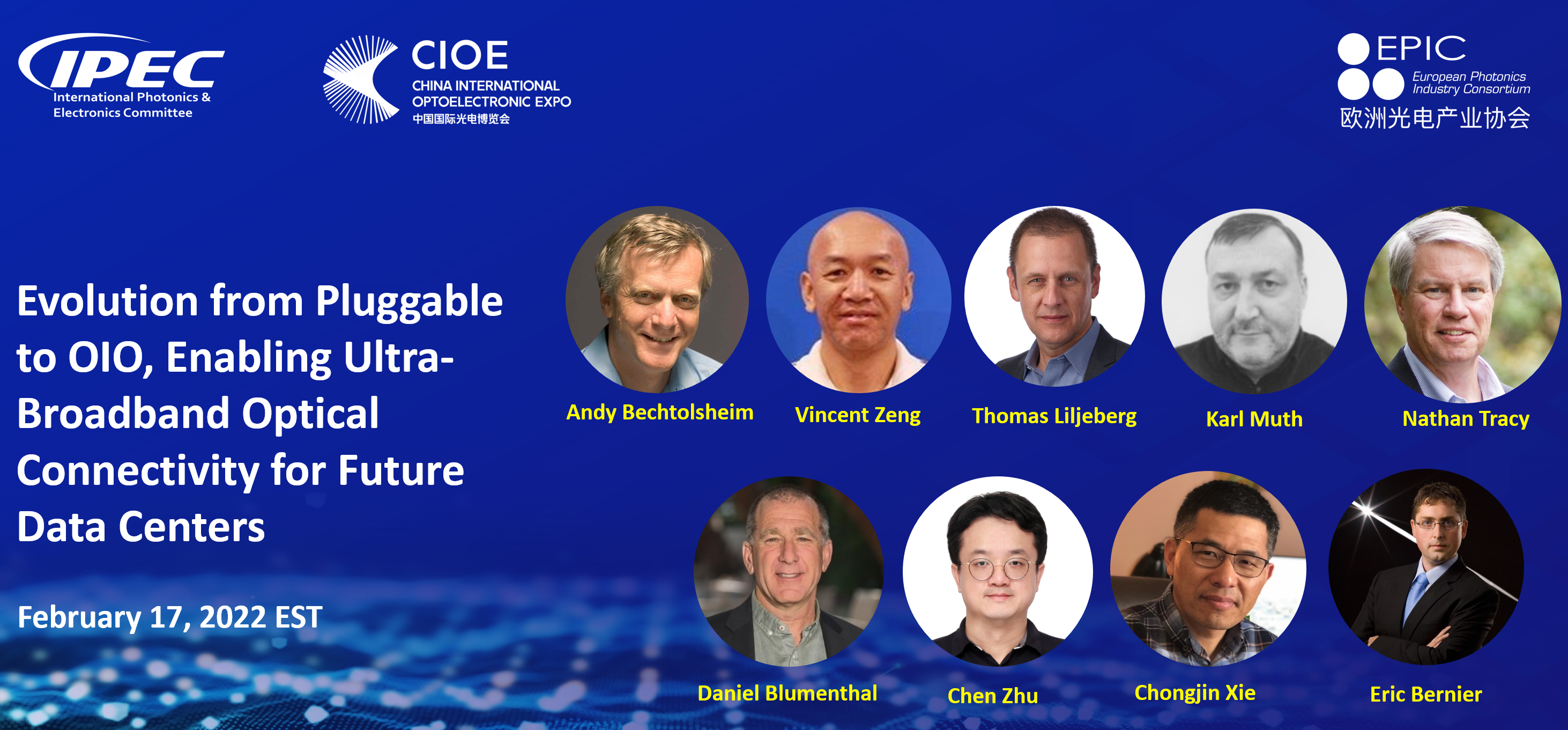Evolution from Pluggable to OIO, Enabling Ultra-Broadband Optical Connectivity for Future Data Centers
On February 17, 2022 (EST), the Global Advanced Optoelectronic Technology Webinar was successfully co-hosted by the International Photonics & Electronics Committee (IPEC), China International Optoelectronic Exposition (CIOE), and European Photonics Industry Consortium (EPIC). The webinar was themed “Evolution from Pluggable to OIO, Enabling Ultra-Broadband Optical Connectivity for Future Data Centers,” and focused on high-speed optical connections for next-generation data centers, in addition to exploring cutting-edge technologies such as 100+ Tbit/s ultra-large switching capacity in the optoelectronic industry.

Optical Input/Output (OIO) is a cutting-edge technology in the optoelectronic field. At the webinar, experts from different companies and academic institutions, including Arista Networks, Meta (formerly Facebook), Intel, Broadcom, TE Connectivity, UC Santa Barbara, Baidu, Alibaba, and Huawei, had an in-depth discussion on the maturity, deployment scenarios, and challenges of OIO, outlining the development blueprint for the technology.
When will OIO enter the market?
1.OIO is regarded as the next-generation optical interconnection technology. Some experts believe that OIO deployment will be required when the switching capacity reaches 51.2 Tbit/s, and that when the switching capacity reaches 100 Tbit/s, we can say the OIO era has begun. However, other experts think that pluggable solutions can perfectly adapt to the 51.2 Tbit/s or 100 Tbit/s switching capacity, and the next-generation solution is still to be identified. Nevertheless, all participants agree that OIO will coexist with pluggable solutions for a long time. There is also a consensus that OIO faces many technical challenges such as complex techniques, and it will take time for OIO to enter the market on a large scale.
2.Which scenarios will first adopt the OIO optical transmission technology?
From pluggable to Co-Packaged Optics (CPO), and even next-generation OIO, the industry has long been looking for optical interconnection solutions with low power consumption and cost, in order to meet the bandwidth requirements of large data centers in the future. Data center switching networks have been identified as the first scenario to adopt OIO, with other application scenarios including CPU, GPU, and TPU in the XPC and AI fields. In addition to switches, AI and supercomputing will become the pioneering markets of OIO.
3.What challenges will OIO face?
First, a mature industry chain needs to be built. OIO integrates optical and electrical technologies and packages optical engines and switching chips. Therefore, the entire industry chain, from the switching chip to the optical engine and packaging, must work together to drive technology maturity. Second, after OIO is deployed, there will be major changes in 100+ Tbit/s switching networks, systems, devices, and optoelectronic components, presenting a series of challenges. Additionally, the power consumption and cost need to be further reduced. In terms of reliability, OIO has to achieve a failure rate one order of magnitude lower than that of pluggable solutions. There are also challenges in configuration flexibility, maintainability, and feasibility, necessitating open discussion and collaborative efforts from the entire optoelectronic industry.
Frank Chang, Chairman of the Advanced Research Work Group of IPEC, gave a succinct summary of the webinar. He stated that in the future, with our joint efforts, advanced optoelectronic technologies such as 800G and OIO will boost industry development like never before. As an open industry standards platform, IPEC has begun research into the innovative 100+ Tbit/s OIO technology. IPEC will focus on addressing the issues and challenges impacting this field, and will gather industry forces to promote the standardization, innovation, and application of next-generation optoelectronic technologies.
About IPEC
The International Photonics & Electronics Committee (IPEC) is an international standards organization that is committed to developing open optoelectronic standards and delivering strategic roadmap reports. IPEC focuses on standardizing solutions in optical chips, optical/electrical components, and optical modules. Markets addressed by IPEC include 5G, IoT and AI.
By February 2022, the number of IPEC members has increased from 13 to 32. Currently, the IPEC members include China Telecom, China Academy of Information and Communications Technology (CAICT), Meituan, Huawei, FiberHome, Broadex, CIG Shanghai Co., Ltd., Wenzhou Yihua Connector, Fujitsu Optical Components (FOC), Hisense Broadband, HG Genuine, Source Photonics, Yamaichi, AOI, InnoLight, ZTE, AROPTICS-TECH, Mindsemi, Accelink, O-Net, H3C, YOFC, Foxconn, Shanghai Jiao Tong University, Sitrus Technology, Semtech, Advanced Fiber Resources, ATOP Corporation, SiFotonics, Intel, Acon Optics, and JONHON.
IPEC is open to any interested party who wishes to join. All members have the opportunity to participate in developing all IPEC standards and reports on a non-discriminatory basis. The process of developing these standards and reports is transparent to all members. IPEC is registered in Switzerland.


